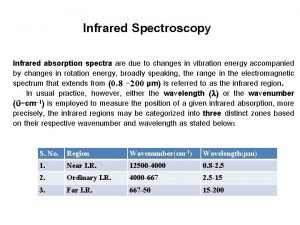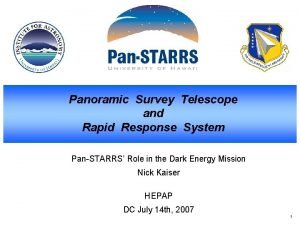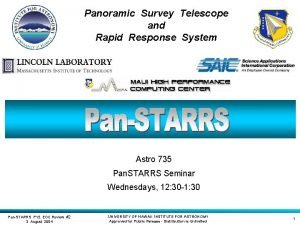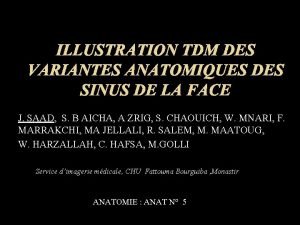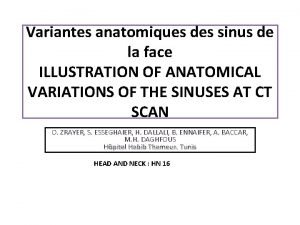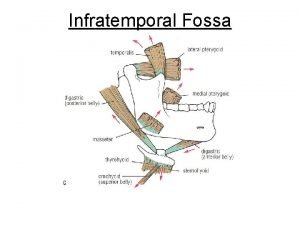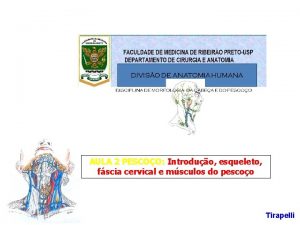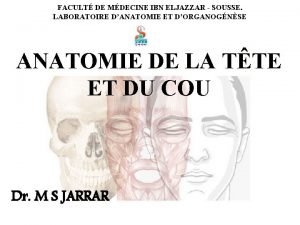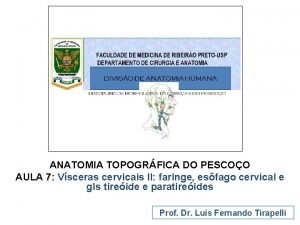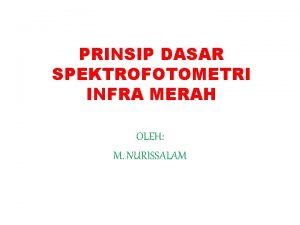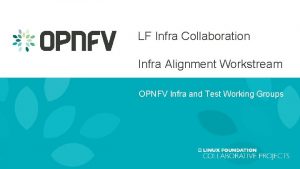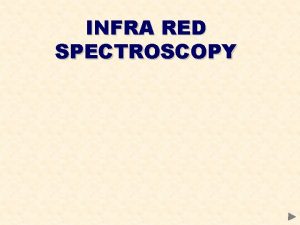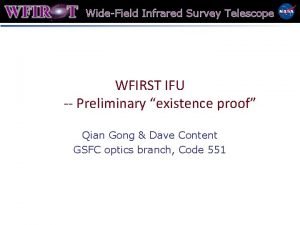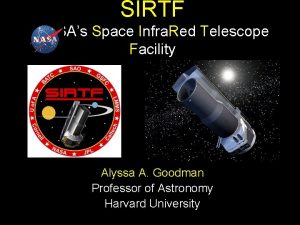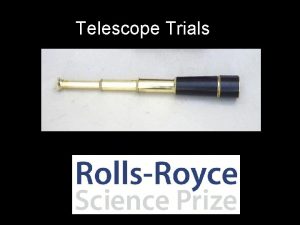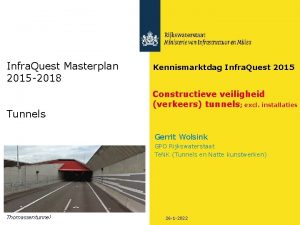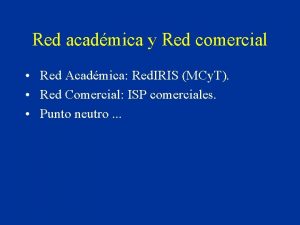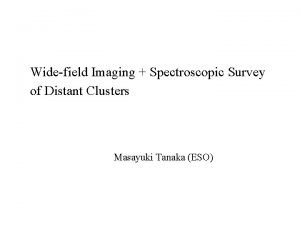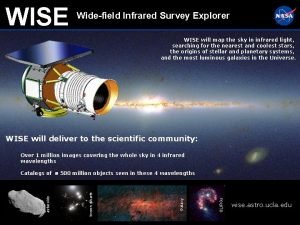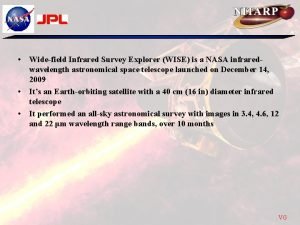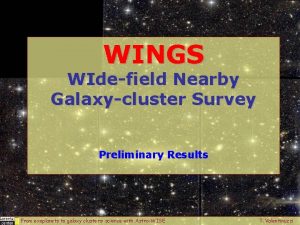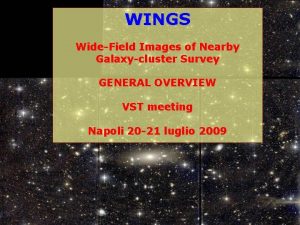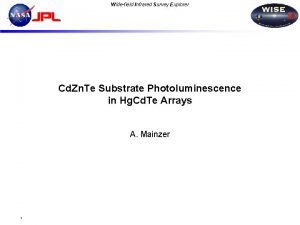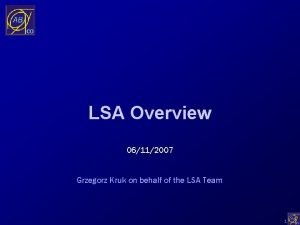WideField Infra Red Survey Telescope Jeff Kruk NASAGSFC
































- Slides: 32

Wide-Field Infra. Red Survey Telescope Jeff Kruk (NASA-GSFC) U. S. Radio/mm/sub-mm Science Futures in the 2020’s 12/17/15 1

Outline Ø Mission Overview § Observatory § Science Program Ø Planned Wide-Area Surveys § Weak-lensing, galaxy redshift survey § Supernova Ia surveys Ø Project Status Ø Q&A 12/17/15 Kruk - WFIRST - Radio Futures in 2020's 2

Historical Context - 1 Ø 1995 First exoplanet discovered by radial velocity Ø 1998, 1999: first papers find expansion of universe is accelerating (Type Ia supernovae) Ø 2002 First exoplanet discovered by transit Ø 2003 National Research Council recommends NASA/DOE Dark Energy Mission (Connecting Quarks to the Cosmos) Ø 2003 NASA Beyond Einstein probe roadmap Ø 2004 First exoplanet discovered by microlensing Ø 2004 First NASA/DOE Joint Dark Energy Mission SDT Ø 2005 JDEM mission concept studies begin Ø 2006 Microlensing Planet Finder proposal Ø 2006 TPF-C Science & Technology Definition Team report 12/17/15 Kruk - WFIRST - Radio Futures in 2020's 3

Historical Context - 2 Ø 2007 NRC recommends JDEM 2009 start Ø 2009 Kepler launch § 1030 confirmed planet detections, 4696 candidates Ø 2009 Astro-2010 white paper submissions § Mission concepts: • JDEM-Omega • Microlensing Planet Finder • Near Infra. Red Sky Surveyor Ø 2010 NRC recommends WFIRST § Merger of above 3 science programs (& many nonmission-specific white papers), using JDEM-Omega observatory concept 12/17/15 Kruk - WFIRST - Radio Futures in 2020's 4

WFIRST Mandate Ø 2010 NRC (NWNH) recommends WFIRST: § Why is the expansion rate of the universe accelerating? And are there other solar systems like ours, with worlds like Earth? § To measure the properties of dark energy, WFIRST will employ three different techniques: • carry out a detailed study of weak lensing that will provide distance and rate -of-growth information; • monitor distances and expansion rate using baryon acoustic oscillations • detect about 2, 000 distant supernova explosions, which can be used to measure distances. § WFIRST will carry out a powerful extrasolar planet search by monitoring a large sample of stars in the central bulge of the Milky Way for small deviations in brightness due to microlensing by intervening solar systems. This census, combined with that made by the Kepler mission, will determine how common Earth-like planets are over a wide range of orbital parameters. § WFIRST will also offer a guest investigator program 12/17/15 Kruk - WFIRST - Radio Futures in 2020's 5

WFIRST pre-Formulation Ø 2010 WFIRST SDT#1 convened Ø 2012 NASA acquisition of 2 NRO telescopes Ø 2012 WFIRST SDT#2 convened § Final Report: http: //arxiv. org/abs/1503. 03757 Ø 2014 NRC declares AFTA consistent w/NWNH § http: //www. nap. edu/catalog/18712/evaluation-of-the -implementation-of-wfirstafta-in-the-context-of-newworlds-new-horizons-in-astronomy-and-astrophysics Ø 2015 Mid-Decadal Review § WFIRST presentations October 2015, January 2016 12/17/15 Kruk - WFIRST - Radio Futures in 2020's 6

WFIRST Observatory Concept Key Features Ø Telescope: 2. 4 m aperture primary Ø Instruments § Wide Field Imager/Spectrometer & Integral Field Unit § Internal Coronagraph with Integral Field Spectrometer Ø Data Downlink Rate: 275 Mbps downlink Ø Data Volume: 11 Tb/day Ø Orbit: Sun-Earth L 2 Ø Launch Vehicle: Delta IV Heavy Ø Mission Duration: 6 yr, 10 yr goal Ø Serviceability: Observatory designed to be robotically serviceable Ø GSFC: leads mission and I&T, wide field instrument, spacecraft Ø JPL: leads telescope, coronagraph 12/17/15 Kruk - WFIRST - Radio Futures in 2020's 7

WFIRST Instruments Wide-Field Instrument • • • Imaging & spectroscopy over 1000 s of sq. deg. Monitoring of SN and microlensing fields 0. 7 – 2. 0 mm (imaging) & 1. 35 -1. 89 mm (spec. ) 0. 28 deg 2 Fo. V (100 x JWST Fo. V) 18 H 4 RG detectors (288 Mpixels) 6 filter imaging, grism + IFU spectroscopy Coronagraph • Image and spectra of exoplanets from super-Earths to giants • Images of debris disks • 430 – 970 nm (imaging) & 600 – 970 nm (spec. ) • Final contrast of 10 -9 or better • Exoplanet images from 0. 1 to 1. 0 arcsec 12/17/15 Kruk - WFIRST - Radio Futures in 2020's 8

WFIRST Payload Optical Block Diagram 12/17/15 Kruk - WFIRST - Radio Futures in 2020's 9

Telescope Assembly Outer Barrel Assembly (OBA) Scarf Door Forward Optics Assembly (FOA) SM Support Structure Focus Drive Actuators Secondary Mirror (SM) SM Baffle SM Support Tubes Primary Mirror (PM) PM Baffle Outer Barrel Extension Fwd Metering Structure Alignment Drive Actuators Aft Metering Structure FOA Bipods OBA Bipods 12/17/15 Telescope Control Electronics Kruk - WFIRST - Radio Futures in 2020's 10

Wide Field Instrument Layout and Major Subassemblies 12/17/15 Kruk - WFIRST - Radio Futures in 2020's 11

AFTA Provides the First Wide-Field High Resolution Map of the Milky Way In RCW 38 (2 MASS J & H shown) WFIRST-AFTA will reach 1000 x deeper with 20 x better angular resolution JWST 12/17/15 HST Ø Protostellar variability Ø Cluster membership identification down WFIRST-AFTA FOV to the hydrogen burning limit Ø Dust extinction mapping. Kruk - WFIRST - Radio Futures in 2020's 12

M 31 PHAT Survey Dalcanton et al. 2012 432 Hubble WFC 3/IR pointings

M 31 PHAT Survey 432 Hubble WFC 3/IR pointings 2 WFIRST pointings

Scientific Objectives 1) Produce NIR sky images and spectra over 1000's of sq deg (J = 27 AB imaging, F_line = 10 -16 erg cm-2 sec-1) 2) Determine the expansion history of the Universe and the growth history of its largest structures in order to test possible explanations of its apparent accelerating expansion including Dark Energy and modifications to Einstein's gravity. 3) Complete the statistical census of planetary systems in the Galaxy, from the outer habitable zone to free floating planets 4) Directly image giant planets and debris disks from habitable zones to beyond the ice lines and characterize their physical properties. 5) Provide a robust guest observer program utilizing a minimum of 25% of the time over the 6 year baseline mission and 100% in following years. 12/17/15 Kruk - WFIRST - Radio Futures in 2020's 15

WFIRST Dark Energy Program 12/17/15 Kruk - WFIRST - Radio Futures in 2020's 16

WFIRST Dark Energy Roadmap 12/17/15 Kruk - WFIRST - Radio Futures in 2020's 17

Microlensing Technique Great benefit of space observations in the crowded galactic bulge field 12/17/15 Kruk - WFIRST - Radio Futures in 2020's 18

Completing the Statistical Census of Exoplanets Combined with space-based transit surveys, WFIRST-AFTA completes the statistical census of planetary systems in the Galaxy. 12/17/15 Kruk - WFIRST - Radio Futures in 2020's 19

Completing the Statistical Census of Exoplanets Combined with space-based transit surveys, WFIRST-AFTA completes the statistical census of planetary systems in the Galaxy. • 2600 planet detections. • 370 with Earth mass and below. • Hundreds of freefloating planets. WFIRST perfectly complements Kepler, TESS, and PLATO. 12/17/15 Kruk - WFIRST - Radio Futures in 2020's 20

Coronagraphy Ø Multi-band imaging at high contrast provides for direct detection and preliminary characterization of exoplanets Simulated WFIRST-AFTA CGI images of a 30 zodidisk around 47 UMa. Simulated WFIRST-AFTA coronagraph image of the star 47 Ursa Majoris, showing two directly detected planets. 12/17/15 Each coronagraph pointing will yield day-long WFI deep-fields (0. 28 sq deg). Kruk - WFIRST - Radio Futures in 2020's 21

WFIRST Brings Us Closer to Characterizing exo-Earths Ø WFIRST-AFTA advances many of the key elements needed for a coronagraph to image an exo-Earth ü Coronagraph ü Wavefront sensing & control ü Detectors ü Algorithms 12/17/15 Kruk - WFIRST - Radio Futures in 2020's 22

Planned Wide-area Surveys Ø Based on 2015 Science Definition Team Report Ø This is an example of how the mission may be planned, but final surveys may differ § Much flexibility in choice of DE surveys § May well choose to go wider, shallower 12/17/15 Kruk - WFIRST - Radio Futures in 2020's 23

WFIRST Surveys Ø Multiple surveys: § High Latitude Survey • Imaging, spectroscopy, supernova monitoring § Repeated Observations of Bulge Fields for microlensing § 25% Guest Observer Program § Coronagraph Observations Ø Flexibility to choose optimal approach 12/17/15 Kruk - WFIRST - Radio Futures in 2020's 24

WFIRST High-Latitude Survey 12/17/15 Kruk - WFIRST - Radio Futures in 2020's 25

WFIRST SN Ia Ø SN discovery via imaging Ø IFU Spectrophotometry for follow-up Ø Need spectrum to measure redshift & confirm type Ø Need rest-frame spectral energy distribution to obtain luminosity at fiducial wavelengths and to correct for dust extinction § Obtain spectra or multi-band imaging light-curves 12/17/15 Kruk - WFIRST - Radio Futures in 2020's 26

WFIRST SN Ia Ø IFU Spectrophotometry for light curves 12/17/15 Kruk - WFIRST - Radio Futures in 2020's 27

Example Observing Schedule Ø High-latitude survey (HLS: imaging + spectroscopy): 2. 01 years § 2227 deg 2 @ ≥ 3 exposures in all filters (2279 deg 2 bounding box) Ø Ø 6 microlensing seasons (0. 98 years, after lunar cutouts) SN survey in 0. 63 years, field embedded in HLS footprint 1 year for the coronagraph, interspersed throughout the mission Unallocated time is 1. 33 years (GO program) Galactic Plane Ecliptic Plane Celestial Equator Microlensing Fields High-Latitude Survey Area SN Fields 12/17/15 Kruk - WFIRST - Radio Futures in 2020's 28

DE Survey specifics SNIa Discovery Imaging Weak Lensing Imaging Survey 1. 683 Redshift Tier <0. 4 Area Sq deg 27. 4 1. 774 2. 000 <0. 8 9 28. 3 0. 13” 0. 14” <1. 7 5 29. 2 29. 1 Exp time 5 x 174 6 x 174 5 x 174 5σ pt src depth 26. 56 26. 70 26. 54 25. 76 32. 8 35. 2 19. 0 Parameter Y J λmin(μm) 0. 927 1. 131 1. 380 λmax(μm) 1. 192 1. 454 PSF (REE 50) 0. 12” WL Neff /sq amin N/A H F 184 Survey area: 2227 sq deg Galaxy depth ~1 mag shallower (r 1/2 ~0. 3”) PSF ~ HST/WFC 3 -IR, with slightly smaller pixels 12/17/15 Y J 27. 5 H Always observe in WFI & IFU WFI parallel observing with coronagraph will give many dozens of deep fields (AB~30? ) Kruk - WFIRST - Radio Futures in 2020's 29

Program Status Ø Substantial technical progress on WFIRST over the past two years: § § NIR detector maturation Coronagraph technology demonstrations Observatory integrated modeling Telescope temperature under study • Present report assumes pessimistic result • Likely to be able to extend bandpass to somewhere between 2. 0 and 2. 4μm – Should know answer in coming year 12/17/15 Kruk - WFIRST - Radio Futures in 2020's 30

Program Status Ø Mission Concept Review completed Dec 8 -9. Ø KDP-A planned for mid-February 2016. § Nominal date Oct 1 2016, but February 2016 likely Ø SDT 2014 & 15 studies completed Ø Preparatory Science teams selected Ø Formulation Science team NRA released – selections early Dec ‘ 15! Ø Significant international interest (Canada, ESA, Japan, Korea) Ø Launch: mid 2024 12/17/15 Kruk - WFIRST - Radio Futures in 2020's 31

THE END 12/17/15 Kruk - WFIRST - Radio Futures in 2020's 32
 Kruk investor relations
Kruk investor relations Kruk
Kruk Kruk i lis tekst
Kruk i lis tekst Infra red
Infra red Panoramic survey telescope and rapid response system
Panoramic survey telescope and rapid response system University of hawaii
University of hawaii 叫叫 abcd
叫叫 abcd Muscle sterno-cléido-mastoïdien
Muscle sterno-cléido-mastoïdien Occipitofrontalis innervation
Occipitofrontalis innervation Que es el infra sexo
Que es el infra sexo Regio infratemporalis
Regio infratemporalis Procidence carotidienne sinus sphénoïdal
Procidence carotidienne sinus sphénoïdal E-commerce infrastructure
E-commerce infrastructure Cide suffix
Cide suffix Pneumatisation des clinoïdes antérieurs
Pneumatisation des clinoïdes antérieurs Mgm infra
Mgm infra Pterygopalatine fossa
Pterygopalatine fossa Acanthiomeatal line
Acanthiomeatal line Infra
Infra Odor hircino
Odor hircino Integrated design project report example
Integrated design project report example Foramen supra piriforme
Foramen supra piriforme Infra verbaal
Infra verbaal Dialight obstruction light
Dialight obstruction light Trigonos do pescoço
Trigonos do pescoço Action grand pectoral
Action grand pectoral Maa ja vesirakennus tes
Maa ja vesirakennus tes Aponevrose interpterygoidienne
Aponevrose interpterygoidienne Supracontacto
Supracontacto Infra
Infra Toni and guy indirapuram
Toni and guy indirapuram Esternocleidomastoideo
Esternocleidomastoideo Prinsip spektrofotometri ir
Prinsip spektrofotometri ir



